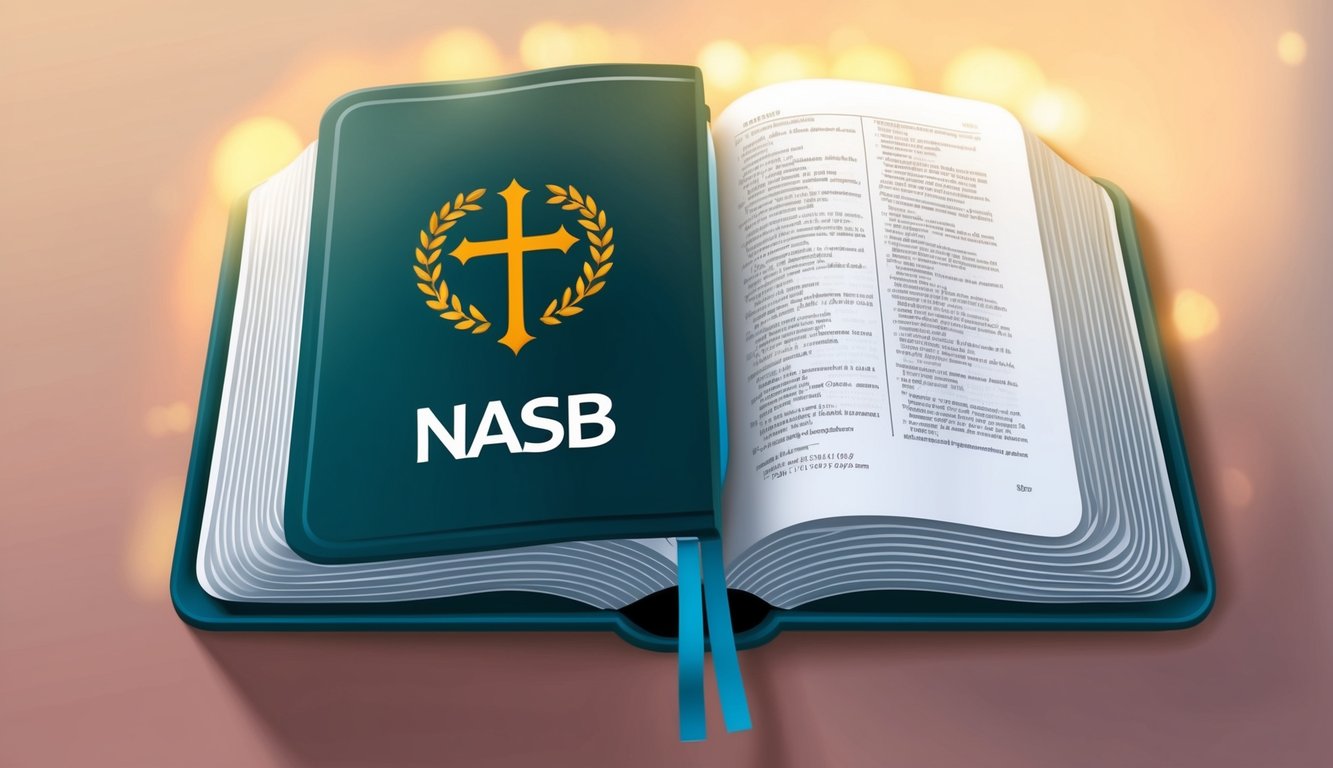Don’t Miss Out On This Unique Astrological Opportunity
Are you tired of spinning your wheels and getting nowhere? Simply put, you’re out of sync: you’re out of alignment with your astral configuration.
But: there’s a kind of map that can help you reclaim your alignment. Think of it as your own personal blueprint to success and happiness: a blueprint that will help you live your most amazing life.
Get started here.
The New American Standard Bible (NASB) aims to stay true to the original texts while speaking in a way we can understand today.
As you dive into its pages, you’ll find that it sticks close to the method of formal equivalence translation.
This makes the NASB an ideal choice for anyone looking for an accurate, literal English Bible.
Developed by the Lockman Foundation, the NASB has undergone several revisions.
The latest update in 2020 enhances its readability while keeping its accuracy intact.
This version brings the scripture to life with modern English, bridging the gap between the ancient texts and today’s readers.
Whether you’re exploring theological themes or just curious about scripture, the NASB can offer you a fresh perspective.
When you read the NASB, you’re engaging with a text that values both faithfulness to original biblical languages and contemporary accessibility.
You get a structured layout that helps navigate verses, making it easy for you to find answers to frequently asked questions or deeper spiritual insights.
It serves not just as a tool for scholars, but as a daily companion for anyone passionate about understanding the Bible better.
Key Takeaways
- NASB aims for accurate word-for-word translation.
- Latest update in 2020 enhances readability.
- Suitable for both scholars and everyday readers.
Development and Translation Philosophy
The New American Standard Bible (NASB) is known for its accuracy and commitment to the original biblical texts.
It uses a formal equivalence translation approach, making it both modern and faithful to the original manuscripts.
Formal Equivalence and Translation Methodology
When it comes to translation, the NASB focuses on formal equivalence, often called a word-for-word approach.
This means the translation tries to stay as close to the original Hebrew, Greek, and Aramaic texts as possible.
The NASB aims to preserve the structure and word choice of the original languages.
This method can sometimes lead to stiffer English but ensures that you get a literal translation.
It’s particularly favored among those who prioritize authenticity and accuracy over smooth reading.
Evolution of NASB Editions
The NASB has undergone significant changes over the years, starting with its roots in the American Standard Version from the early 20th century.
Managed by the Lockman Foundation in La Habra, California, newer editions like the NASB 1995 have focused on minor updates for better readability.
NASB 2020 further modernized the language, catering to contemporary English speakers while maintaining the integrity of the original texts.
These updates make it easier for you to read and understand the Bible without losing the depth and accuracy that the NASB is known for.
Structure and Features of the NASB Bible

The NASB Bible offers a precise translation known for its commitment to reflecting the original languages.
You’ll find that it prioritizes a literal format to enhance your understanding of the biblical texts.
Book Organization and Verse Structure
In the NASB Bible, books are arranged in the traditional order found in Protestant Bibles.
This includes the Old Testament, followed by the New Testament.
Each book is divided into chapters and verses, making it easier for you to locate specific passages.
The verse structure strives to match the original texts closely.
For example, in the Gospel of John, the wording is carefully chosen to stay as true to the Greek texts as possible.
This literal format might seem different at first, but it helps in maintaining the core meanings of the scriptures.
Textual Notes and References
The NASB provides numerous textual notes and references that are informative for deeper study.
These include information about different manuscripts used, such as the Dead Sea Scrolls and the Masoretic Text.
You’ll find footnotes that explain variations between ancient versions and the NASB translation choices.
These notes are useful for understanding why certain words or phrases are used.
You can see how the NASB translators worked to maintain clarity and accuracy.
It’s especially helpful when studying complex sections or comparing them with other translations to grasp nuances in the text better.
These annotations help readers mark 10 key features of the translation process, shedding light on linguistic choices and textual variations.
By examining these details, you can gain deeper insight into the original meaning and the translators’ intent.
This makes it easier to appreciate the precision and faithfulness of the NASB translation.
Theological Themes in the NASB

In the NASB Bible, you’ll discover rich theological themes focusing on the nature of God, His creation, the life, and redemption offered through Jesus Christ.
Through these themes, you can dive deeper into your faith journey and explore the profound truths of Scripture.
Creation and the Nature of God
The NASB starts with a powerful portrayal of God’s creation.
You’ll find that Genesis 1:1 highlights the beginning, as it states, “In the beginning, God created the heavens and the earth.” This sets the stage for understanding God’s mighty power.
God is shown as creative and intentional.
Each element, from light to water, is crafted by His command.
The creation is declared “very good,” reflecting His nature and purpose for the world.
The spirit of God moves over the waters, symbolizing His active presence in the world.
Through these passages, you’re reminded of God’s role as the Creator and Sustainer of life.
The contrast between light and darkness reflects spiritual truths, setting the foundation for understanding your place in God’s plan.
Jesus Christ and Redemption
Jesus Christ’s life and mission are central to the NASB’s message of redemption.
Through His actions and teachings, you encounter the essence of God’s love and grace.
John 14:6 highlights His declaration: “I am the way, and the truth, and the life.”
In your journey, Jesus offers redemption from sin, emphasizing faith and love as key components of a relationship with God.
You see His sacrifice as pivotal for humanity, bridging the gap between mankind and the Lord.
These texts encourage you to reflect on the significance of Christ’s sacrifice and how it brings salvation to the world.
As you explore these passages, you’ll find inspiration and hope in living a life aligned with the Lord Jesus Christ.
Frequently Asked Questions
You might have many questions about the New American Standard Bible (NASB).
Here, we’ll explore where you can find free versions, the differences between versions, and what makes the NASB unique compared to others.
Where can I find a free online NASB Bible?
You can access a free NASB Bible on websites like Bible Gateway and YouVersion.
These platforms offer the full text of the NASB and other translations.
You might also find additional tools, like reading plans and study notes, to enhance your reading experience.
What are the key differences between the 1995 and 2020 editions of the NASB Bible?
The 1995 update improved clarity and readability while staying true to the original text.
The 2020 edition focuses on even more clarity and includes updates that reflect modern language and usage, making it approachable without losing its accuracy.
How can I download the New American Standard Bible for free?
YouVersion offers a free download of the NASB Bible app.
It’s available for most smartphones and tablets.
This lets you read offline, bookmark, or highlight verses.
Check if other Bible apps also provide free access to the NASB.
What distinguishes the NASB Study Bible from other study Bibles?
The NASB Study Bible is known for its comprehensive notes and references, often attributed to scholars like Dr. John MacArthur.
The notes aim to provide greater insight into the scriptures, making it a favorite for those wanting detailed explanations and historical context.
In what ways does the NASB Bible differ from the NKJV?
The NASB is known for its word-for-word translation approach, emphasizing accuracy from the original texts.
The NKJV updates the traditional King James Version language to modern English while maintaining its literary style.
Both prioritize faithfulness to the original scriptures but differ in translation philosophy and style.
Which denominations typically use the New American Standard Bible?
The NASB is popular among evangelical Christians who prioritize precision in translation.
It is often used in academic and devotional settings, where a close representation of the original texts is valued.
Many non-denominational churches also appreciate its rigorous approach to scripture translation.



